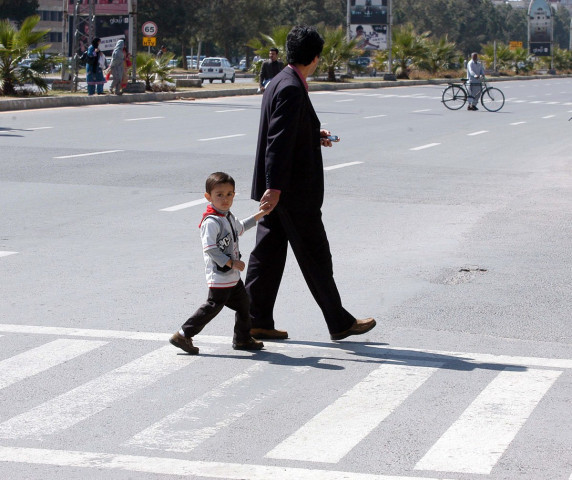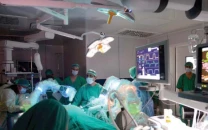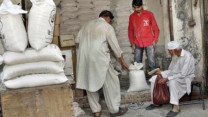Roads in Pakistan remain dangerous for pedestrians
One-fifth of the people killed on roads annually in the country are believed to be pedestrians.

A boy and his father walk over a zebra crossing. PHOTO: MUHAMMAD JAVAID/
Walking is a common mode of transport in Pakistan, but is increasingly dangerous due to the associated risk of road accidents. High rates of motorisation, increased frequency of vehicle use, neglect of pedestrian needs in road design, and weak enforcement of traffic laws all contribute to heightening pedestrians’ vulnerability in Pakistan, where one-fifth of all road fatalities are believed to be pedestrians.
Here we take a look at the weaknesses in our road design and how road safety can be improved in Pakistan.
Missing infrastructure
Pedestrian safety and walking environment are closely associated. Our roads lack pedestrian safety infrastructure, which is why walking on or crossing roads is a high-risk activity. The risk of motor vehicle-pedestrian collisions is increasing in proportion to motorisation and general public’s attitude to occupy road front for business and other activities. Pedestrians mostly fall victim to these accidents while crossing the road. It is a failure of our road designing and planning authorities in providing basic facilities to pedestrians such as sidewalks, road crossings, and safe access ways at junctions.
No right of way: Zebra crossings on the verge of extinction
Safety awareness
Inaction is deep-rooted in the society of Pakistan. People have accepted pedestrian collisions as inevitable. but all kinds of vehicular collisions are predictable, hence preventable. A majority of citizens seldom own their personal safety and are seen blaming other road users or bad luck for road accidents. Rarely does a road user in Pakistan admit to a mistake and hold themselves responsible for a road accident. Existing road crossing facilities are sparsely used due to several unpardonable reasons. Underpasses remain choked with water due to inadequate drainage, while overhead bridges pose a security risk. But the main hurdle is people’s mindset and ignorant attitude which always stimulate them to take short cuts.
Red flags in the system
A number of contributing factors are making our roads unsafe for pedestrian movement. Inadequate visibility of pedestrians makes them highly vulnerable. A high frequency of pedestrian collisions is typically seen at dawn, dusk, and during the first hour of darkness. Visibility of pedestrians is affected by the absence or derelict condition of streetlights, while vehicles and two wheelers’ often have faulty lights, and pedestrians wear no reflective accessories. Other factors adding to pedestrians’ sufferings include inadequate enforcement of traffic laws, unsafe driving practices, driver and pedestrian distraction, use of mobile phones, drivers fatigue, pedestrian-vehicle conflicts at pedestrian crossings, delayed responses of elderly people, incapability of children to estimate vehicle speed, and lack of supervision of children who are too young to make safe judgments.
Why expanding roads will not ease traffic in Karachi
The attitudes of drivers and pedestrians towards road safety is the same – both believe the other will take evasive measures. With this attitude, drivers fail to respect the right of way of pedestrians and vice-versa. Vehicles with faulty brakes, lights, horns, or cracked windscreen increase the collision risk with pedestrians manifold. Mix traffic, encroached footpaths, distracted walking, less-controlled crossings and low-risk awareness place pedestrians at greater risk and lead to mayhem on our roads.
Vehicle-focussed planning
In Pakistan, roads are designed generally to cater to the needs of motorised traffic, neglecting the needs of pedestrians. A recent study showed that Pakistan has one of the lowest rates of footpath prevalence among low and middle-income countries. Around 84 per cent of roads lack footpaths. Road designs without facilities such as sidewalks and signalised crossings create risk for pedestrians. Arterial roads, junctions and fast-speed lanes are being operated without adequate attention to pedestrian facilities resulting in increased pedestrian casualties when walking alongside or crossing the road.
Why did six students die in Karachi during road construction?
Possible solutions
The crashes between pedestrians, cyclists and vehicular traffic can be reduced by introducing a transport system with exclusive lanes and pedestrian-friendly raised crossings and markings on the road. Installation of automatic electronic signals to control all traffic movements at intersections including pedestrian traffic is a well-proved intervention. Provision of continuous wide footpaths on both sides of the road could be a short-term solution. Marking of pedestrian-holding areas at the roadside, at each junction, where pedestrians can wait before crossing the road can also be helpful. A wide zebra strip – ideally five metres – at pedestrian crossings, preceded by a stop line, provides a safe zone for pedestrians to cross in front of stationary vehicular traffic, and the installation of “rumble strips” can also reduce the speed of vehicles. Detailed analysis of pedestrian collisions needs to be carried out to find out specific causes of accidents in specific areas. Also, rigorous hard-hitting social marketing campaigns are needed to educate pedestrians about the safe use of roads.
Social and health aspect
Road safety up till now has not been dealt as social and health issue, rather it is taken as an isolated transport sector problem. The prevailing pathetic condition of pedestrian safety demands a social emergency regarding road safety where it should become the voice of the town and be discussed at all levels. We have to sensitise not only pedestrians but all of society towards this menace which engulfs the hopes of numerous parents before they come to fruition. It is a shared responsibility and all the policies and interventions could only be effective if all the stakeholders own it and play their respective role in curbing pedestrian casualties. As a nation, we can move ahead swift when we learn to give respect and safety to our pedestrians.
Ashfaq Ahmad Klair is a road safety expert and a senior patrol officer with National Highways and Motorways Police.



















COMMENTS
Comments are moderated and generally will be posted if they are on-topic and not abusive.
For more information, please see our Comments FAQ